AMD EPYC 7232P Benchmarks
For this exercise, we are using our legacy Linux-Bench scripts which help us see cross-platform “least common denominator” results we have been using for years as well as several results from our updated Linux-Bench2 scripts. Starting with our 2nd Generation Intel Xeon Scalable benchmarks, we are adding a number of our workload testing features to the mix as the next evolution of our platform.
At this point, our benchmarking sessions take days to run and we are generating well over a thousand data points. We are also running workloads for software companies that want to see how their software works on the latest hardware. As a result, this is a small sample of the data we are collecting and can share publicly. Our position is always that we are happy to provide some free data but we also have services to let companies run their own workloads in our lab, such as with our DemoEval service. What we do provide is an extremely controlled environment where we know every step is exactly the same and each run is done in a real-world data center, not a test bench.
We are going to show off a few results, and highlight a number of interesting data points in this article.
Python Linux 4.4.2 Kernel Compile Benchmark
This is one of the most requested benchmarks for STH over the past few years. The task was simple, we have a standard configuration file, the Linux 4.4.2 kernel from kernel.org, and make the standard auto-generated configuration utilizing every thread in the system. We are expressing results in terms of compiles per hour to make the results easier to read:
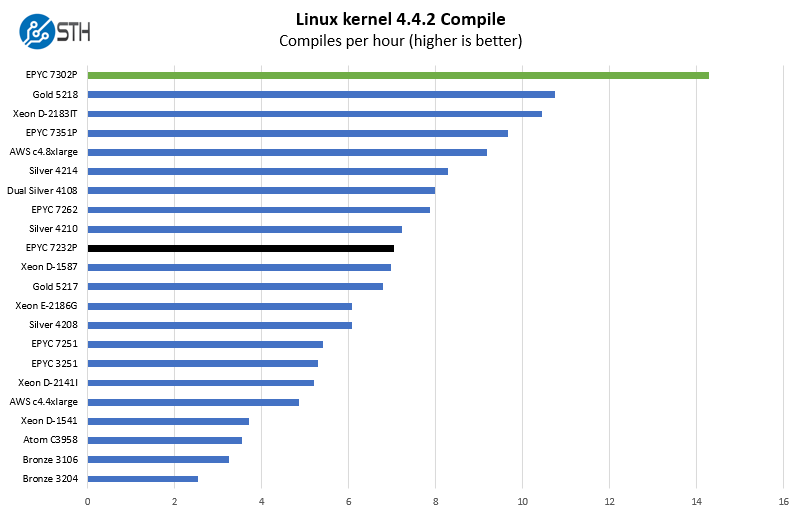
These charts were very difficult to make. We have plenty of data, but what competes in this segment. To us, there are a few competitive vectors.
First, there is the single-socket market. As a “P” series part, the AMD EPYC 7232P is a single-socket only CPU. We can see this being used in servers that do not require enormous amounts of compute like storage servers. Here, the competition is not just the Intel Xeon Bronze and Silver lines, but also the Xeon E-2100, Xeon D, and Atom C3000 series.
There is also competition from AMD’s other SKUs as well as dual socket options. In the end, we made some large charts. We added the EPYC 7262 to show the higher cache version. We also added the AMD EPYC 7302P. For around $400 more, there are a lot of applications we can see the AMD EPYC 7302P is a better choice. There is simply more performance if one needs it moving up the SKU stack. We are going to highlight both of these results in our charts.
c-ray 1.1 Performance
We have been using c-ray for our performance testing for years now. It is a ray tracing benchmark that is extremely popular to show differences in processors under multi-threaded workloads. We are going to use our 8K results which work well at this end of the performance spectrum.
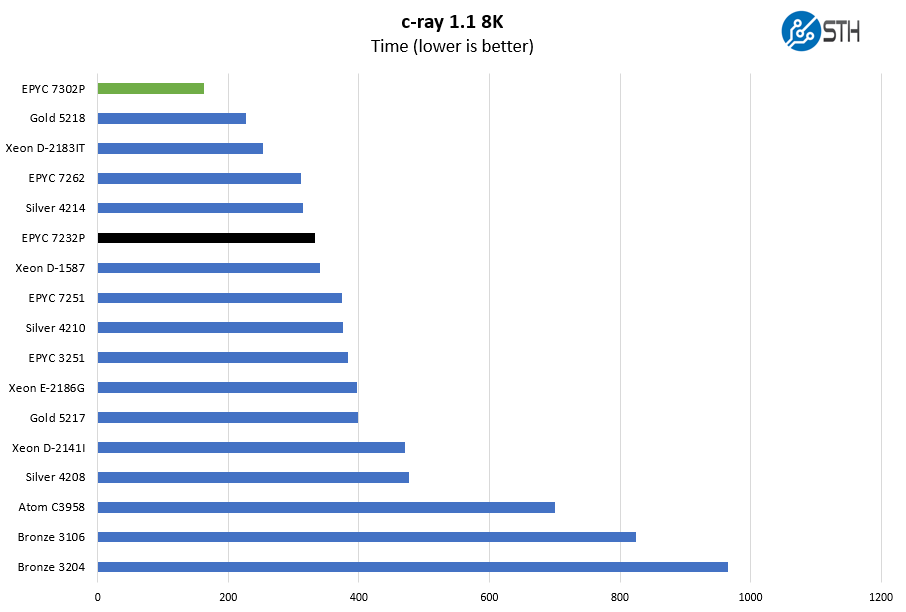
One of the big changes in the 2019 generation of processors is a bump in performance. Something you will see throughout this article is the jump in this generation from the AMD EPYC 7251 to the EPYC 7232P. Both are eight-core CPUs, but the EPYC 7232P benefits from being a single NUMA node on a newer architecture. This is a big upgrade for the single-socket EPYC platform.
7-zip Compression Performance
7-zip is a widely used compression/ decompression program that works cross-platform. We started using the program during our early days with Windows testing. It is now part of Linux-Bench.
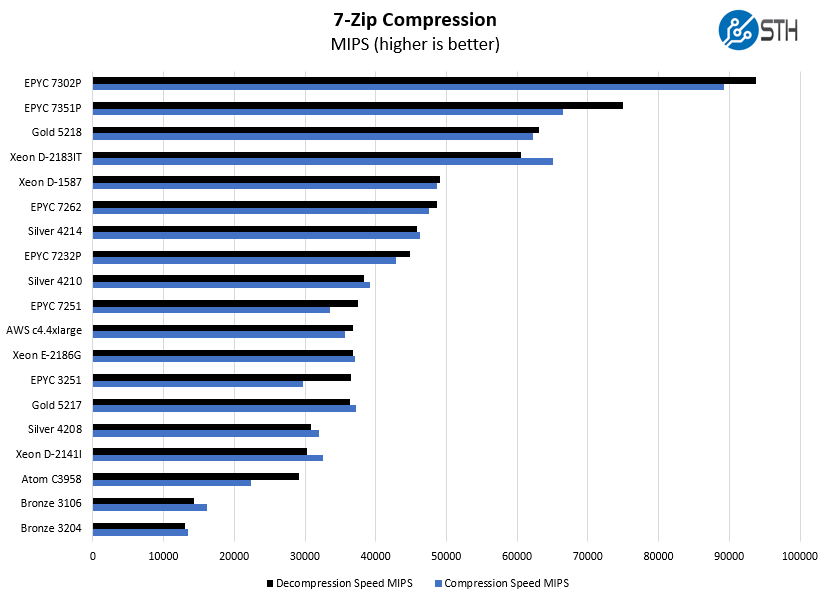
The EPYC 7232P is near the middle of the chart, and we see it fall between the Intel Xeon Silver 4210 and Intel Xeon Silver 4214. That is a good result given the pricing. It is still competitive on a CPU for CPU basis, yet has the expansion capabilities of more than two Intel Xeon Scalable processors.
NAMD Performance
NAMD is a molecular modeling benchmark developed by the Theoretical and Computational Biophysics Group in the Beckman Institute for Advanced Science and Technology at the University of Illinois at Urbana-Champaign. More information on the benchmark can be found here. With GROMACS we have been working hard to support AVX-512 and AVX2 supporting AMD Zen architecture. Here are the comparison results for the legacy data set:
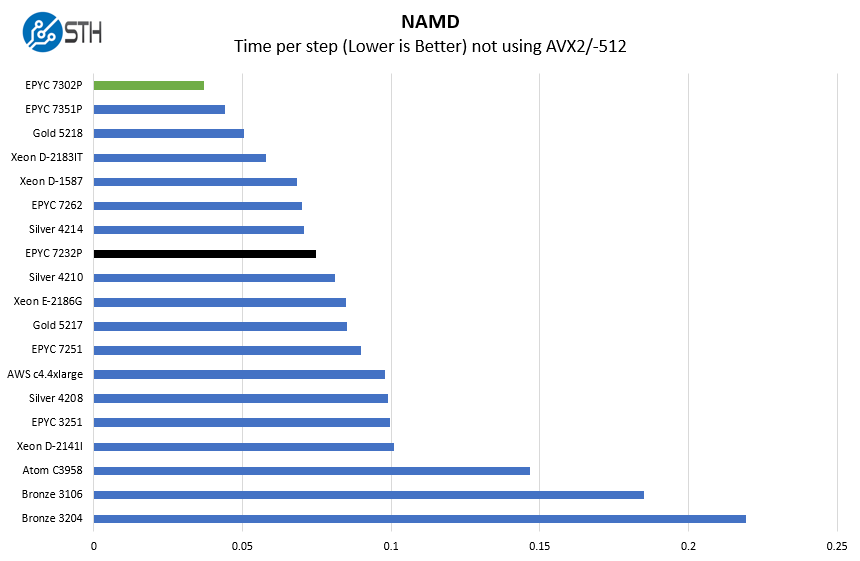
A slightly interesting question is whether it makes sense to upgrade to the EPYC 7262. It is faster on most workloads, like this NAMD test, but it is not an enormous delta. For single-socket workloads, it seems like the progression should be EPYC 7232P to 7302P instead of the intermediary dual-socket SKUs.
OpenSSL Performance
OpenSSL is widely used to secure communications between servers. This is an important protocol in many server stacks. We first look at our sign tests:
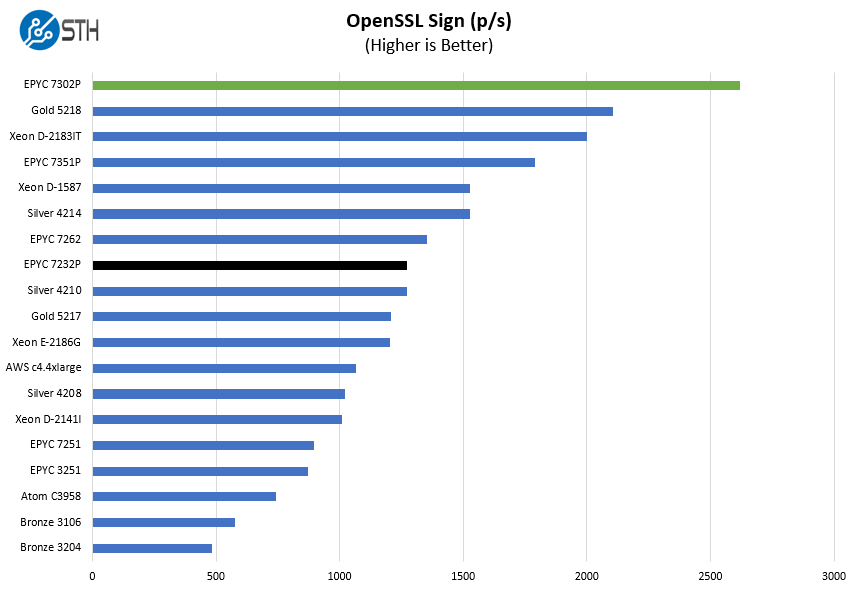
Here are our verify results:
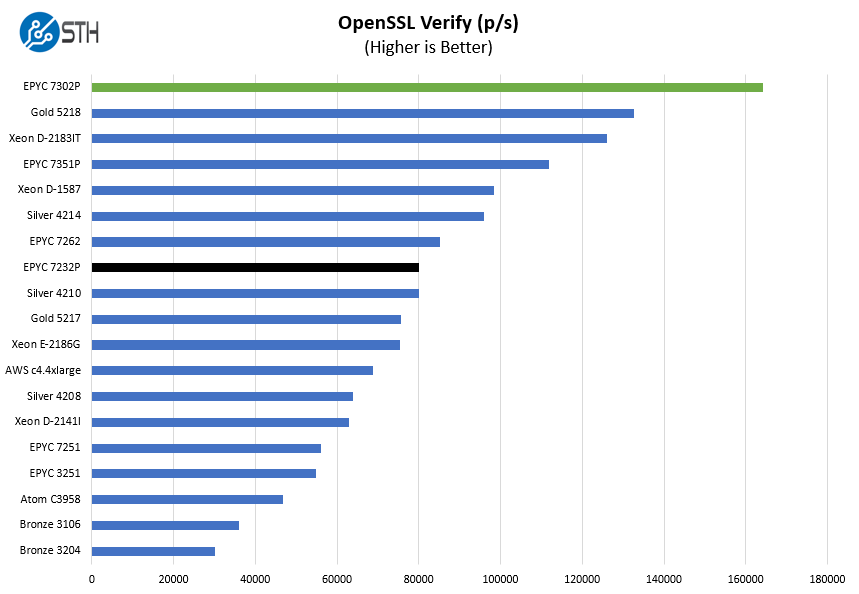
One of the more intriguing results here is that the AMD EPYC 7232P is outpacing the Intel Xeon Gold 5217. Given the delta in price between those two chips, one would not expect this to happen.
UnixBench Dhrystone 2 and Whetstone Benchmarks
Some of the longest-running tests at STH are the venerable UnixBench 5.1.3 Dhrystone 2 and Whetstone results. They are certainly aging, however, we constantly get requests for them, and many angry notes when we leave them out. UnixBench is widely used so we are including it in this data set. Here are the Dhrystone 2 results:
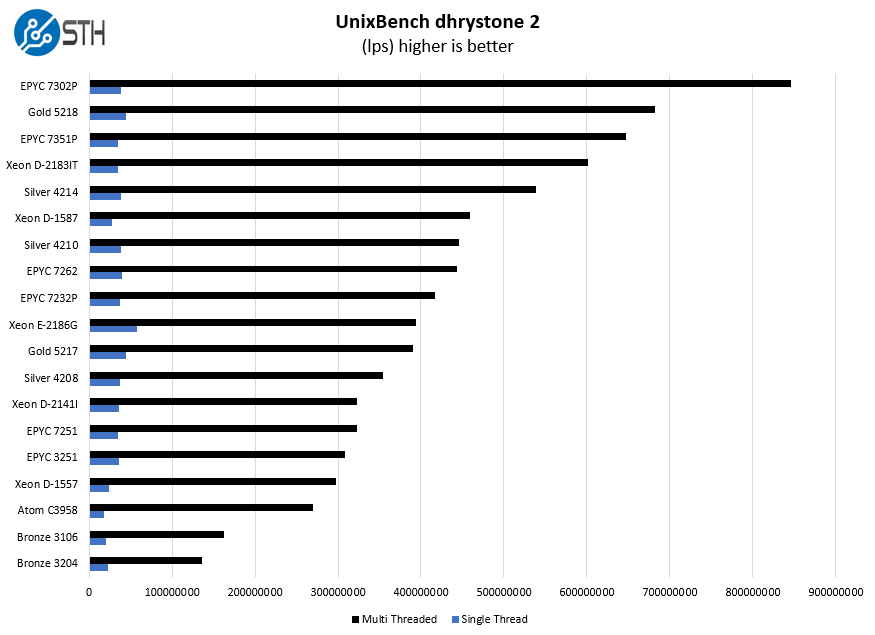
Here are our whetstone results:
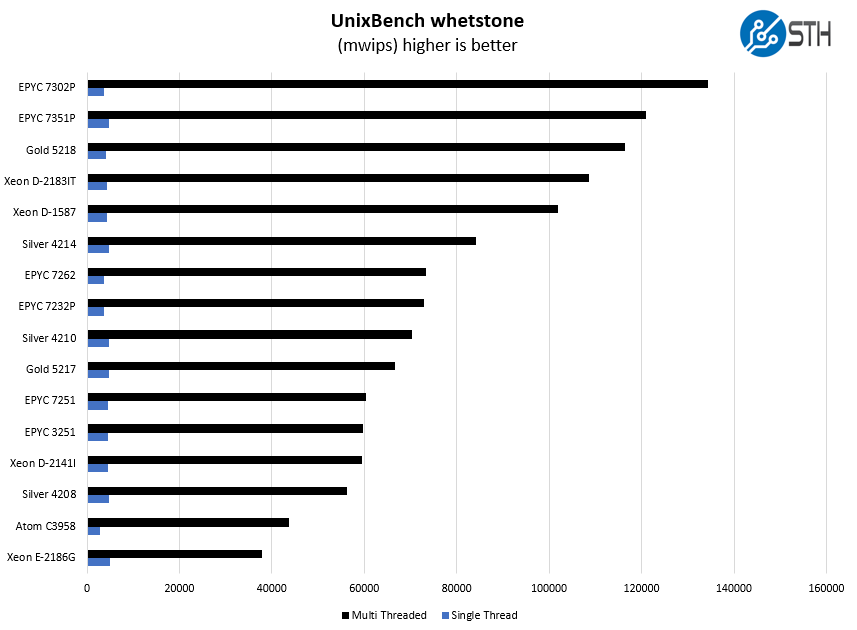
There are still some per-core benefits to an Intel Xeon E-2100 or E-2200 solution. That is one area that Intel still has a single socket advantage although it is not as well pronounced in the Intel Xeon Scalable line. The Intel Xeon E series has severely constrained PCIe I/O and memory capacity.
Sysbench CPU test
Sysbench is another one of those widely used Linux benchmarks. We specifically are using the CPU test, not the OLTP test that we use for some storage testing.
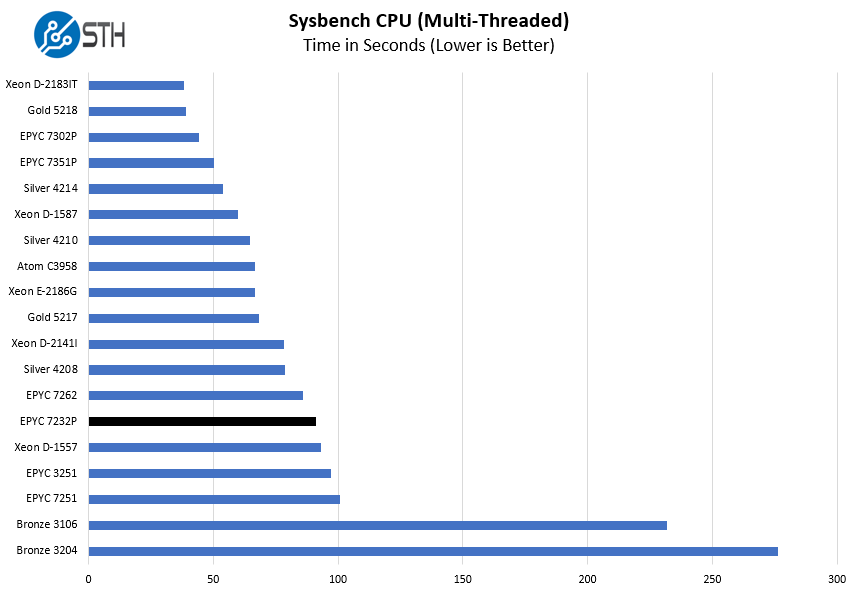
We wanted to also show the single thread numbers:
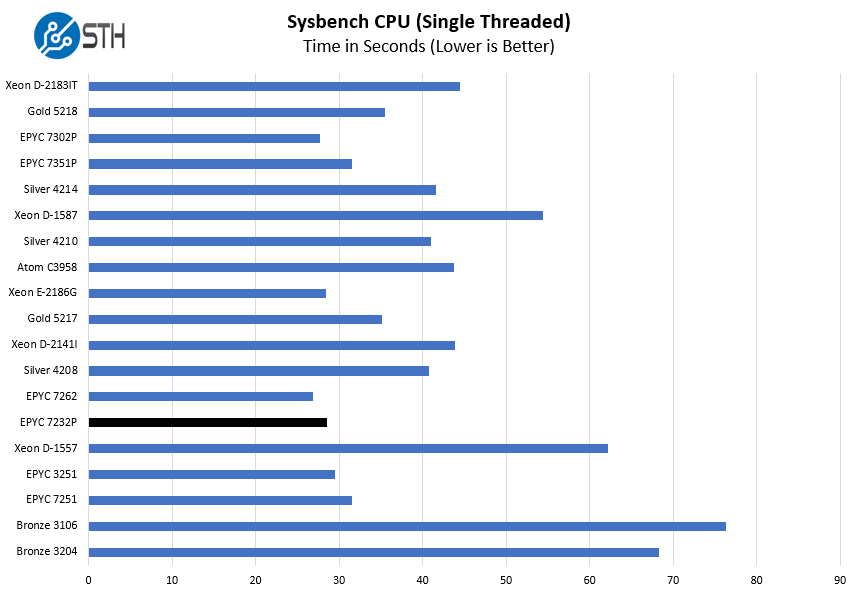
The AMD EPYC 7232P is doing well both in per-core performance, as well as loaded per-core performance. That is a big deal. If you look at the dual Intel Xeon Bronze and many of the Intel Xeon Silver benchmarks in this review, you will see that Intel does not have a distinct per-core performance advantage at this point.
Chess Benchmarking
Chess is an interesting use case since it has almost unlimited complexity. Over the years, we have received a number of requests to bring back chess benchmarking. We have been profiling systems and are ready to start sharing results:
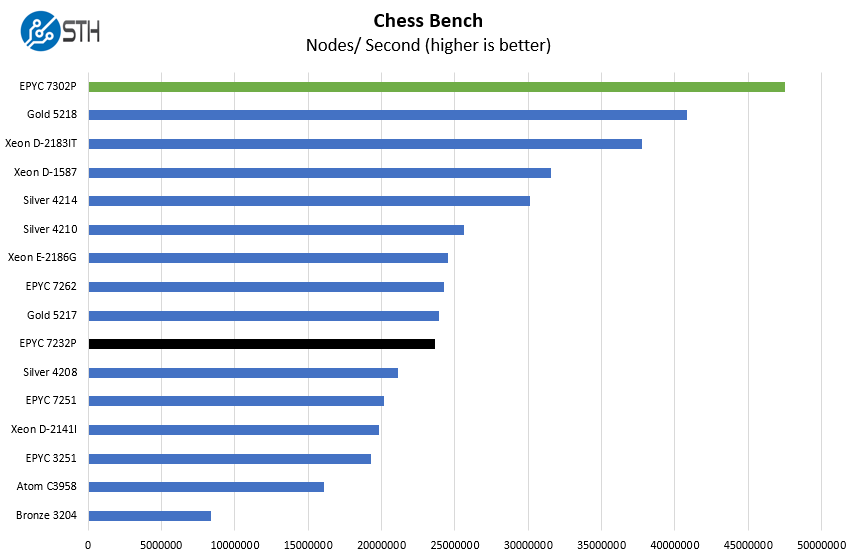
Still, we come back to the question of AMD EPYC 7232P versus 7302P. The lowest-cost AMD EPYC 7002 single-socket servers we have seen are around $1100-$1200 barebones. Assuming a fairly minimal RAM and storage configuration, the total cost (before markups and discounts) will be in the $2000-3000 range. Even at that lower end of the range if an option can give you 80-100% more performance for $400 or 20% of the cost, then that can be hard to turn down if you can consolidate an additional machine. Our chess benchmarks show this delta fairly clearly.
Next, we are going to get to our market positioning before our final words.




I get what you’re saying. $375 more for the 7302p’s straight up a better deal
Squalor was one of the funniest ones you’ve had since the channel cobbler line. It’s spot on. The El cheapo servers that are sold in volumes but nobody cares about.
We use Xeon Silver 2 per for ZFS boxes. We’re going to try a 7232P and 7302P now and see how they’re working. If we can use the 7232P that’ll save us so much. Getting more PCIe lanes means more drives attached per controller node
I like the phrase “light the platform” for CPUs like this. You don’t buy it because you need crazy amounts of CPU performance, you buy it because it’s the cheapest CPU that’ll go in the socket and enable all the other platform features you do need, like massive PCIe.
I can see this CPU being used in a lot of NVMe storage nodes.
How did you determine the 7232P has a 4*(2c + 8MB) configuration vs. 2*(4c + 16MB)? This would be the first confirmed Zen part with fractionally disabled L3, and people are bickering about it on Twitter, etc.